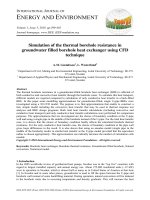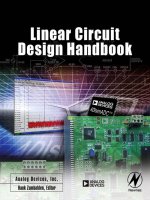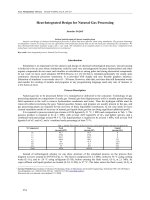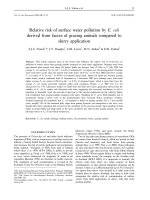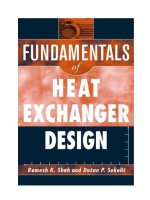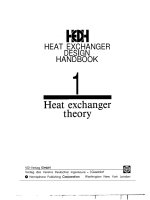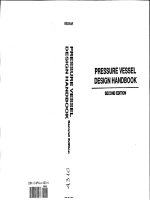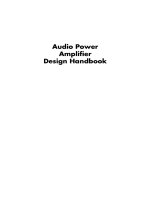heat exchanger design handbook (1st issue), by e u schlunder
Bạn đang xem bản rút gọn của tài liệu. Xem và tải ngay bản đầy đủ của tài liệu tại đây (49.42 MB, 2,305 trang )
HEAT EXCHANGER
DESIGN
HANDBOOK
1
Heat
exchanger
theory
VDI-Verlag
GmbH
Verlag des Vereins Deutscher lngenieure l
Dijsseldorf
0
Hemisphere Publishing Cor$oration
Washington New York London
,*
_.II
.
-*ll
l_(.i
~.I.
I^ olll-x
.
_
I
f
l.m_.*
~ -~~~
EDITORIAL BOARD
Ernst
U.
Schltinder, Editor-in-Chief
Lehrstuhl und Institut
ftir
Thermische Verfahrenstechnik der
Universitat Karlsruhe TH, D-7500 Karlsruhe 1, Kaiserstrasse 12,
Postfach 6380, F.R. Germany
Kenneth
J.
Bell
School of Chemical Engineering, Oklahoma State University,
Stillwater, Oklahoma 74078, U.S.A.
Duncan Chisholm
Department of Trade and Industry, National Engineering
Laboratory, East Kilbride, Glasgow G75 OQU, Scotland
Geoffrey F. Hewitt
Engineering Sciences Division, Atomic Energy Research
Establishment, Harwell
OX11
ORA,
U.K.
Frank
W. Schmidt
Mechanical Engineering Department, Pennsylvania State University,
University Park, Pennsylvania 16802, U.S.A.
D.
Brian
Spalding
Department of Mechanical Engineering, Imperial College of Science
and Technology, Exhibition Road, London SW7
2BX,
U.K.
Jerry
Tahorek
Heat Transfer Research, Inc., 1000 South Fremont Avenue,
Alhambra, California 91802, U.S.A.
Algirdas
iukauskas
The Academy of Sciences of the Lithuanian SSR, MTP-1,
Lenin0
pr. 3, 232600 Vilnius, U.S.S.R.
V. Gnielinski, Associate Editor
Lehrstuhl und Institut fur Thermische Verfahrenstechnik der
Universitat Karlsruhe TH, D-7500 Karlsruhe 1, Kaiserstrasse 12,
Postfach 6380, F.R. Germany
PUBLISHED UNDER THE AUSPICES OF THE INTERNATIONAL CENTRE FOR HEAT AND MASS TRANSFER
Heat Exchanger Design Handbook
Copyright
0
1983 by Hemisphere Publishing Corporation. All rights reserved. Printed in the
United States of America. Except as permitted under the United States Copyright Act of
1976, no part of this publication may be reproduced or distributed in any form or by any
means, or stored in a data base or retrieval system, without the prior permission of the
publisher.
1234567890 BCBC 898765432
This book was set in Press Roman by Hemisphere Publishing Corporation.
Editors: Brenda Munz Brienza, Judith B. Gandy, and Lynne Lackenbach.
Production supervisor: Miriam Gonzalez.
Compositors: Peggy M. Rote, Sandra F. Watts, Shirley J.
McNett,
and Wayne Hutchins,
BookCrafters,
Inc., was printer and binder.
Distribution outside the U.S.A., Canada, Mexico, U.K., and Ireland, by VDI-Verlag,
Diisseldorf.
The publisher, editors, and authors have maintained the highest possible level of scientific
and technical scholarship and accuracy in this work, which is not intended to supplant
professional engineering design or related technical services, and/or industrial or
international codes and standards of any kind. The publisher, editors, and authors assume
no liability for the application of data, specifications, standards or codes published herein.
Library
of Congress Cataloging in Publication Data
Main entry under title:
Spalding,
D. B. (DudIey Brian),
date-
Heat exchanger theory.
(Heat exchanger design handbook; 1)
Kept up to date by supplements.
Includes index.
1. Heat exchangers. I. Taborek, J. II. Title.
III. Series.
TJ263.H38
1983
vol. 1
621.4025s
ISBN 3-1841-9081-l (VDI Part 1)
[621.4022]
ISBN
3-1841-9080-3
(VDI set)
ISBN O-891 16-125-2 (Hemisphere set)
82-9265
AACR2
Contributors
D. Brian Spalding
Department of Mechanical Engineering, Imperial
College of Science and Technology, Exhibition
Road, London SW7 2BX U.K.
J.
Taborek
Heat Transfer Research, Inc., 1000 South
Fremont Avenue, Alhambra, California 9 1802
U.S.A.
CONTENTS
1.1
1.1.0
1.1.1
1.1.2
1.1.3
1.1.4
1.1.5
1.1.6
1
Heat
exchanger
theory
Contributors
x111
General Preface xv
Part
1
Preface
xvii
Nomenclature
xix
International System of Units (SI):
Rules, Practices, and Conversion Charts,
J. Taborek
xxv
DESCRIPTION OF HEAT
EXCHANGER TYPES
Structure of the Section,
D. Brian Spalding
Types of Flow Configuration,
D. Brian
Spalding
Types of Interactions between Streams,
D. Brian Spalding
Types of Temperature Change Pattern,
D. Brian Spalding
\
Types of Interface between Streams,
D. Brian Spalding
Types of Heat Exchange Equipment,
D. Brian Spalding
Unsteady Operation,
D. Brian Spalding
1.2
1.2.0
1.2.1
1.2.2
1.2.3
1.2.4
1.2.5
1.2.6
1.3
1.3.1
1.3.2
1.4
1.4.1
DEFINITIONS AND QUANTITATIVE
RELATIONSHIPS FOR HEAT
EXCHANGERS
Structure of the Section, D. Brian Spalding
Thermodynamics: Brief Notes on
Important Concepts,
D. Brian Spalding
Flux Relationships,
D. Brian Spalding
Transfer Coefficient
Dependences,
D. Brian
Spalding
Balance Equations Applied to Complete
Equipment, D. Brian Spalding
The Differential Equations Governing
Streams, D. Brian Spalding
Partial Differential Equations for
Interpenetrating Continua,
D. Brian
Spalding
ANALYTIC SOLUTIONS TO HEAT
EXCHANGER EQUATIONS
Uniform-Transfer-Coefficient Solutions for
the No-Phase-Change Heat Exchanger,
D. Brian Spalding
Other Analytic Solutions,
D. Brian Spalding
NUMERICAL SOLUTION
PROCEDURES FOR HEAT
EXCHANGER EQUATIONS
Cases with Prescribed Flow Patterns,
D. Brian Spalding
Rev. 1986
._I_._
_.
.
-1,.
._
__
l_l
.
-
__._.
_ ,
_
-,
-t
vi
HEAT EXCHANGER DESIGN HANDBOOK
/
Contents
1.4.2
1.4.3
1.5
1.5.1
1.5.2
1.5.3
1.6
1.6.1
1.6.2
1.6.3
1.6.4
1.6.5
1.6.6
1.6.7
1.6.8
1.6.9
2.1
Cases in Which the Flow Patterns Must Be
Calculated, D. Brian Spalding
Special Applications of Numerical Solution
Procedures, D. Brian Spalding
CHARTS FOR MEAN
TEMPERATURE DIFFERENCE IN
INDUSTRIAL HEAT EXCHANGER
CONFIGURATIONS
Introduction,
J. Taborek
F
and
13
Charts for Shell-and-Tube
Exchangers,
J. Taborek
F
and
19
Charts for Cross-Flow
Arrangements,
J . Taborek
EFFECTIVENESS OF MULTIPASS
SHELL-AND-TUBE HEAT
EXCHANGERS WITH SEGMENTAL
BAFFLES (CELL METHOD)
Introduction, E. S. Gaddis
Calculation Procedure,
E. S. Gaddis
Numerical Examples, E. S. Gaddis
Rules for Highest Heat Exchanger
Effectiveness, E. S. Gaddis
Special Case of Two Tube Passes,
E. S. Gaddis
Heat Exchangers with Longitudinal Baffles,
E. S. Gaddis
Cell Effectiveness, E. S. Gaddis
Comparison of the Conventional Method
and the Cell Method, E. S. Gaddis
General Remarks, E. S. Gaddis
Index
I-l
2
Fluid
mechanics
and heat transfer
Contributors
x111
General Preface xv
Part 2 Preface
xvii
Nomenclature xix
International System of Units (sIj:
Rules, Practices, and Conversion Charts,
J. Taborek xxv
FUNDAMENTALS OF HEAT AND
MASS TRANSFER
-
2.1.0
2.1.1
2.1.2
2.1.3
2.1.4
2.1.5
2.1.6
2.1.7
2.2
2.2.1
2.2.2
2.2.3
2.2.4
2.2.5
2.2.6
2.2.7
2.2.8
2.3
2.3.1
2.3.2
2.3.3
2.3.4
2.4
2.4.1
2.4.2
2.4.3
2.4.4
2.4.5
2.4.6
2.5
2.5.1
Introduction, E. U.
S&hinder
Physical Mechanisms of Transport
Phenomena, E. U. Schhinder
Industrial Applications of Heat and Mass
Transfer, E. U. Schltinder
Presentation of Heat and Mass Transfer
Data, E. U. Schltinder
Heat and Mass Transfer in Uniform and
Nonuniform Systems, E. U. Schltinder
Analogy between Heat and Mass Transfer
and Its Limitations, E. U. S&hinder
Combined Heat and Mass Transfer,
E. U. Schliinder
State of the Art of Heat and Mass Transfer,
E. U. Schltinder
SINGLE-PHASE FLUID FLOW
Introduction and Fundamentals,
K. Gersten
Ducts, K. Gersten
Immersed Bodies,
K. Gersten
Banks of Plain and Finned Tubes,
A.
%kauskas
and R. Ulinskas
Fixed Beds,
P
J. Heggs
Fluidized Beds, 0. Molerus
Headers, Nozzles, and Turnarounds,
J. A. R. Henry
Non-Newtonian Fluids,
Robert C.
Armstrong
MSJLTIPHASE FLUID FLOW AND
PRESSURE DROP
Introduction and Fundamentals,
G. F. Hewitt
Gas-Liquid Flow, G. F. Hewitt
Solid-Gas
Flow,
M. Weber and W. Stegmaier
Solid-Liquid Flow, M. Weber and
W. Stegmaier
HEAT CONDUCTION
Basic Equations,
H. Martin
Steady State, H. Martin
Transient Response to a Step Change of
Temperature,
H. Martin
Melting and Solidification,
H. Martin
Periodic Change of Temperature,
H. Martin
Thermal Contact Resistance,
T. F. Irvine, Jr.
SINGLE-PHASE CONVECTIVE
HEAT TRANSFER
Forced Convection in Ducts,
V. Gnielinski
Rev. 1986
HEAT EXCHANGER DESIGN HANDBOOK
/
Contents
vii
2.5.2
2.5.3
Forced Convection around Immersed
Bodies, V. Gnielinski
Banks of Plain and Finned Tubes
A. Single Rows and Tube Banks in Cross
Flow, V. Gnielinski
B. Finned Tubes, A. Zukauskas and
A. Skrinska
2.5.4
2.5.5
Fixed Beds,
V. Gnielinski
Fluid-to-Particle Heat Transfer in Fluidized
Beds, S. S. Zabrodsky with revisions by
H. Martin
2.5.6
2.5.7
2.5.8
2.5.9
2.5.10
2.5.11
2.5.12
Impinging Jets, H. Martin
Free Convection around Immersed Bodies,
S. W. Churchill
Free Convection in Layers and Enclosures,
S. W. Churchill
2.5.13
Combined Free and Forced Convection
around Immersed Bodies,
S. W. Churchill
Combined Free and Forced Convection in
Channels, S. W. Churchill
Augmentation of Heat Transfer,
Arthur E.
Bergles
Heat Transfer for Non-Newtonian Fluids,
Robert C. Armstrong and H. H. Winter
Heat Transfer in Liquid Metals,
V. M. Borishanski and E. V. Firsova
2.6
CONDENSATION
2.6.1
2.6.2
2.6.3
General Introduction,
D. Butterworth
Film
Condensation of Pure Vapor,
D . Butterworth
Condensation of Vapor Mixtures,
D. Butter-worth
2.6.4
2.6.5
2.6.6
2.6.7
2.6.8
Condensation of Vapor Mixtures Forming
Immiscible Liquids, R. G. Sardesai
Dropwise
Condensation,
P. Griffith
Augmentation of Condensation,
Arthur
E.
Bergles
Fogging, D. Chisholm
Direct-Contact Condensers,
Harold R.
Jacobs
2.7
BOILING AND EVAPORATION
2.7.1
2.7.2
2.7.3
2.7.4
Boiling of Single Component Liquids: Basic
Processes, J. G. Collier
Pool Boiling, J. G. Collier
Boiling within Vertical Tubes,
J. G. Collier
Convective Boiling inside Horizontal Tubes,
J. G. Collier
2.7.5
Boiling outside Tubes and Tube Bundles,
J. G. Collier
2.7.6
Boiling of Binary and Multicomponent
Mixtures: Basic Processes,
J. G. Collier
2.7.7
2.7.8
2.7.9
2.8
2.8.1
2.8.2
2.8.3
2.8.4
2.9
2.9.1
2.9.2
2.9.3
2.9.4
2.9.5
2.9.6
2.9.7
2.9.8
Boiling of Binary and Multicomponent
Mixtures: Pool Boiling, J. G. Collier
Boiling of Binary and Multicomponent
Mixtures: Forced Convection Boiling,
J. G. Collier
Augmentation of Boiling and Evaporation,
Arthur E. Bergles
HEAT TRANSFER TO GAS-SOLID
SYSTEMS
Stagnant Packed Beds,
R. Bauer
Packed Beds with a Gas Flowing Through,
R. Bauer
Packed and Agitated Packed Beds,
E. Muchowski
Fluidized Beds, J. S. M. Botterill
HEAT TRANSFER BY RADIATION
Introduction, D. K. Edwards
Surface Radiation Characteristics,
D. K. Edwards
Radiation Transfer between Perfectly
Diffuse Surfaces, D. K. Edwards
Radiation Transfer between Specular and
Imperfectly Diffuse Surfaces,
D. K. Edwards
Gas Radiation Properties,
D. K. Edwards
Radiation Transfer with an Isothermal
Gas, D. K. Edwards
Nonisothermal Gas Radiation,
D. K. Edwards
Radiation Acting with Conduction or
Convection, D. K. Edwards
Index I-l
Thermal
and
hydraulic
design
of heat
exchangers
Contributors
x111
General Preface xv
Part 3 Preface xvii
Nomenclature xix
International System of Units (SI):
Rules, Practices, and Conversion Charts,
J. Taborek xxv
Rev. 1986
._.
.
.
__
I__
_
._~~ _--^ _,_
-T ^^T-
.
_ e
.
.
.
Vlll
HEAT EXCHANGER DESIGN HANDBOOK
/
Contents
3.1
INTRODUCTION
To
HEAT
EXCHANGER DESIGN
3.1.1
3.1.2
3.1.3
3.1.4
Fundamental Concepts,
Kenneth J. Bell
Types of Heat Exchangers and Their
Applications,
Kenneth J . Bell
Logic of the Design Process, Kenneth J. Bell
Approximate Sizing of Shell-and-Tube Heat
Exchangers, Kenneth J. Bell
3.2
DOUBLE-PIPE HEAT
EXCHANGERS
3.2.1
3.2.2
3.2.3
3.2.4
3.2.5
3.2.6
3.3
Introduction, A. R. Guy
Applications of Double-Pipe Heat
Exchangers, A. R. Guy
Design Parameters, A. R. Guy
Types Available,
A. R. Guy
Construction/Mechanical Design,
A. R. Guy
Operational Advantages,
A. R. Guy
SHELL-AND-TUBE HEAT
EXCHANGERS: SINGLE-PHASE
FLOW
3.3.1
3.3.2
3.3.3
3.3.4
3.3.5
3.3.6
3.3.7
3.3.8
3.3.9
3.3.10
3.3.11
Objectives and Background,
J. Taborek
Survey of Shell-Side Flow Correlations,
J. Taborek
Recommended Method: Principles and
Limitations,
J
. Taborek
Practices of Shell-and-Tube Heat
Exchanger Design,
J. Taborek
Input Data and Recommended Practices,
J. Taborek
Auxiliary Calculations,
J. Taborek
Ideal Tube Bank Correlations for Heat
Transfer and Pressure Drop,
J. Taborek
Calculation of Shell-Side Heat Transfer
Coefficient and Pressure Drop,
J. Taborek
Performance Evaluation of a Geometrically
Specified Exchanger,
J. Taborek
Design Procedures for Segmentally
BaMed
Heat Exchangers,
J. Taborek
Extension of the Method to Other Shell,
Baffle, and Tube Bundle Geometries,
J. Taborek
3.4
CONDENSERS
3.4.1
3.4.2
3.4.3
Introduction, A. C. Mueller
Selection of Condenser Types,
A. C. Mueller
Discussion of Condenser Types,
A. C. Mueller
3.4.4
3.4.5
3.4.6
3.4.7
3.4.8
3.4.9
3.5
3.5.1
3.5.2
3.5.3
3.5.4
3.5.5
3.5.6
3.5.7
3.5.8
3.6
3.6.1
3.6.2
3.6.3
3.6.4
3.6.5
3.7
3.7.1
3.7.2
3.7.3
3.7.4
3.7.5
3.7.6
3.7.7
3.7.8
3.7.9
3.7.10
3.7.11
3.7.12
Mixtures, A. C. Mueller
Operational Problems, A. C. Mueller
Heat Transfer, A. C. Mueller
Pressure Drop, A. C. Mueller
Mean Temperature Difference,
A. C. Mueller
Design Procedure, A. C. Mueller
EVAPORATORS
Introduction, R. A. Smith
Types of Evaporators,
R. A. Smith
Arrangements, R. A. Smith
Design Details, R. A. Smith
Choice of Type, R. A. Smith
Estimation of Pressure Drop and
Circulation Rate, R. A. Smith
Estimation of Heat Transfer
Coefficients,
R. A. Smith
Estimation of Surface Area,
R. A. Smith
SHELL-AND-TUBE REBOILERS
Introduction, J. W. Palen
Thermal Design,
J. W.
Palen
Pressure Drop,
J. W.
Palen
Special Design Considerations,
J. W. Palen
Calculation Procedures,
J. W. Palen
PLATE HEAT EXCHANGERS
Construction and Operation,
Anthony
Cooper and J. Dennis Usher
Factors Governing Plate Specification,
Anthony Cooper and J. Dennis Usher
Corrugation Design, Anthony Cooper and
J. Dennis Usher
Friction Factor Correlations,
Anthony
Cooper and J. Dennis Usher
Heat Transfer Correlations,
Anthony
Cooper and J. Dennis Usher
Factors Affecting Plate Design,
Anthony
Cooper and J. Dennis Usher
Overall Plate Design, Anthony Cooper and
J. Dennis Usher
Plate Arrangement and Correction Factors,
Anthony Cooper and J. Dennis Usher
Fouling, Anthony Cooper and J. Dennis
Usher
Methods of Surface Area Calculation,
Anthony Cooper and J. Dennis Usher
Thermal Mixing, Anthony Cooper and
J. Dennis Usher
Two-Phase Flow Applications,
Anthony
Cooper and J. Dennis Usher
Rev. 1986
HEAT EXCHANGER DESIGN HANDBOOK
/ Contents
iX
3.8
AIR-COOLED HEAT EXCHANGERS
3.8.1
3.8.2
3.8.3
Air as Coolant for Industrial Processes:
Comparison to Water,
P. Paikert
Custom-Built Units,
P. Paikert
Fin-Tube Systems for Air Coolers,
P. Paikert
3.8.4
3.85
3.8.6
3.8.7
3.8.8
Fin-Tube Bundles, P. Paikert
Thermal Rating,
P. Paikert
Tube-Side Flow Arrangements,
P. Paikert
Cooling Air Supply by Fans,
P. Paikert
Cooling Air Supply in Natural Draft
Towers,
P. Paikert
3.8.9
Special Features
of Air Coolers,
P. Paikert
3.9
COMPACT HEAT EXCHANGERS
3.9.1
3.9.2
3.9.3
3.9.4
3.9.5
3.9.6
3.9.7
3.9.8
3.9.9
3.9.10
3.9.11
3.9.12
3.9.13
Introduction, R. L. Webb
Definition of Geometric Terms,
R. L. Webb
Plate Fin Surface Geometries,
R. L. Webb
Surface Performance Data,
R. L. Webb
Laminar Flow Surfaces,
R. L. Webb
Correlation of Heat Transfer and Friction
Data, R. L. Webb
Goodness Factor Comparisons,
R. L. Webb
Specification of Rating and Sizing
Problems, R. L. Webb
Calculation Procedure for a Rating
Problem, R. L. Webb
Pressure Drop Calculation,
R. L. Webb
Procedures for the Thermal Sizing
Problem, R. L. Webb
Multifluid Service, R. L. Webb
Recent Theory and Data on Vaporization
and Condensation,
R. L. Webb
3.10
HEAT PIPES
3.10.1
3.10.2
Introduction, D. Chisholm
Circulation and Axial Heat Transfer,
D. Chisholm
3.10.3
3.10.4
3.10.5
3.10.6
3.10.7
Temperature Distributions and Radial Heat
Transfer Flux, D. Chisholm
Axial Heat Transfer and the Operational
Envelope, D. Chisholm
Selection of Working Fluid,
D. Chisholm
Characteristics of Wicks,
D. Chisholm
Start-up and Control,
D. Chisholm
3.11
FURNACES AND COMBUSTION
CHAMBERS
3.11.1
Introduction, J. S. Truelove
3.11.2 Process Heaters and Boilers,
J. S. Truelove
3.11.3
Heat Transfer in Furnaces,
J. S. Truelove
3.11.4
3.11.5
3.11.6
3.11.7
3.12
The Stirred-Reactor Furnace Model,
J. S.
Truelove
The Plug-Flow Furnace Model,
J. S.
Truelove
The Multizone Furnace Model,
J. S.
Truelove
Advanced Furnace Models,
J. S. Truelove
COOLING TOWERS
3.12.1
Introduction, J. R. Singham
3.12.2
The Packing Region, J. R. Singham
3.12.3
Natural Draft Towers, J. R. Singham
3.12.4
Mechanical Draft Towers,
J. R. Singham
3.12.5
Hybrid Towers, J. R. Singham
3.12.6
Further Topics, J. R. Singham
3.13
DRYERS
3.13.1
3.13.2
3.13.3
3.13.4
3.13.5
3.13.6
Introduction, E. U. Schliinder
Classification and Selection,
E. U.
Schliinder
Layout and Performance Data,
E. U.
Schliinder
Prediction of Drying Rates,
E. U. Schliinder
Prediction of Residence Times with
Prescribed Material Flow, E. U. Schliinder
Prediction of Residence Times with
Nonprescribed Material Flow,
E. U.
S&Kinder
3.13.7
3.14
Practical Dryer Design,
D. Reay
AGITATED VESSELS
3.14.1
3.14.2
3.14.3
3.15
Introduction, W. R. Penney
Equipment, W. R. Penney
Heat Transfer Correlations,
W. R. Penney
REGENERATION AND THERMAL
ENERGY STORAGE
3.15.0
3.15.1
3.15.2
3.15.3
Introduction,
F. W. Schmidt
Operation of Regenerators,
A. J. Willmott
Construction of Regenerator Packing,
A. J.
Willmott
Internal Behavior of a Regenerator:
Development of the Mathematical Model,
A. J. Willmott
3.15.4
3.15.5
3.15.6
3.15.7
Heat Transfer Coefficient,
A. J. Willmott
Use of Bulk or Overall Heat Transfer
Coefftcient,
A. J. Willmott
Development of Dimensionless Parameters,
A. J. Willmott
Calculation of Regenerator Thermal
Performance, A. J. Willmott
Rev. 1986
I
_.ll c-_.
._
.^.
._
.rl
c_
-11._
.I .
,_
_.
-~
,-_-
_p_
X
HEAT EXCHANGER DESIGN HANDBOOK
/
Contents
3.15.8 Effect of Longitudinal Conduction in the
Packing of the Regenerator,
A. J. Willmott
3.15.9 Dealing with Heat Losses,
A. J. Willmott
3.15.10
Transient
Characteristics of Regenerators.
3.15.1
3.15.1
3.16
3.16.1
3.16.2
3.16.3
3.16.4
1 Explicit Design of Balanced Regenerators,
B . Kulakowski
2 Single-Blow Operation,
F. W. Schmidt
WASTE HEAT BOILER SYSTEMS
Description of Typical System,
P. Hinchley
Key Aspects of the Design and Specification
of Individual Items of Plant,
P. Hinchley
Detailed Mechanical Design and
Fabrication of Equipment,
P.
Hinchley
Precommissionhtg of Waste Heat Boiler
Systems, P. Hinchley
3.17
3.17.1
3.17.2
3.17.3
3.17.4
3.17.5
3.17.6
3.17.7
FOULING IN HEAT EXCHANGERS
Overview and Summary,
James G. Knudsen
Types of Fouling, James G. Knudsen
Analysis of the Fouling Process, James G.
Knudsen
Fouling Control Measures,
James G.
Knudsen
Cleaning of Heat Exchangers,
James G.
Knudsen
Measurement of Fouling Resistances,
James G. Knudsen
Recommended Fouling Resistances for
Design, James G. Knudsen
Index I-l
4
Mechanical
desigp
of
heat
exchangers
Contributors
..
x111
General Preface xv
Part 4 Preface
xvii
Nomenclature
xix
International System of Units (SI):
Rules, Practices, and Conversion Charts,
J. Taborek
xxv
4.1 BASIC MECHANICAL PRINCIPLES
4.1.1
Introduction, C.
Ruiz
4.1.2
Methods of Analysis,
C. Ruiz
A. J. Willmott
4.1.3
4.1.4
4.1.5
4.1.6
4.1.7
4.1.8
4.2
Shells, C. Ruiz
Tube Plates,
C. Ruiz
Tubes,
C. Ruiz
Expansion Joints, C.
Ruiz
Flanges, C. Ruiz
Heads, Openings, and Branches,
C. Ruiz
SHELL-AND-TUBE HEAT
EXCHANGERS: ELEMENTS OF
CONSTRUCTION
4.2.1
4.2.2
4.2.3
4.2.4
4.2.5
4.2.6
Introduction, E. A. D. Saunders
Design and Construction Codes,
E.
A. D.
Saunders
Types of Shell-and-Tube Heat Exchangers,
E. A. D. Saunders
Head Types, E. A. D. Saunders
Features Related to Thermal Design,
E. A. D. Saunders
Features Relating to Mechanical Design
and Fabrication, E. A. D. Saunders
4.3
SHELL-AND-TUBE HEAT
EXCHANGERS: REVIEW OF
MECHANICAL DESIGN CODES
4.3.1
4.3.2
4.3.3
4.3.4
4.3.5
4.3.6
Mechanical Design Codes,
M. Morris
Index to U.S., U.K., and F.R.G. Codes,
M. Morris
Analytic Basis of Code Rules,
M. Morris
Comparison of Principal Codes,
M. Morris
Guides to National Practice,
M. Morris
Design Example: Floating-Head Heat
Exchanger, TEMA Type
AJS, D. Harris
4.4
MECHANICAL DESIGN: GENERAL
FORMS OF HEAT EXCHANGERS
4.4.1
4.4.2
4.4.3
4.4.4
4.5
Mechanical Design of Air-Cooled Heat
Exchangers,
K. V. Shipes
Mechanical Design of Plate Heat
Exchangers, J. Dennis Usher
Plate Fin Heat Exchangers,
R. L. Webb
Other Types of Heat Exchangers,
I. Murray
MATERIALS OF CONSTRUCTION
AND CORROSION
4.5.1
4.5.2
4.5.3
Introduction, J. F. Lancaster
Materials of Construction,
J. F. Lancaster
Corrosion and Other Types of Damage,
J. J. Lancaster
4.6
FLOW-INDUCED VIBRATION
4.6.1
Introduction, J. M. Chenoweth
Rev. 1986
HEAT EXCHANGER DESIGN HANDBOOK
/ Contents
xi
4.6.2
Tube Bundle Vibration Characteristics,
J.
M. Chenoweth
4.6.3
4.6.4
Shell-Side Velocities in Shell-and-Tube
Exchangers, J. M. Chenoweth
Flow-induced Vibration Phenomena,
J. M.
Chenoweth
4.6.5
Procedure for Vibration Predictions,
J. M.
Chenoweth
4.6.6
Design Considerations,
J . M . Chenoweth
4.7
TESTING AND INSPECTION
4.7.1
4.7.2
4.7.3
4.7.4
4.7.5
4.7.6
4.7.7
4.7.8
4.7.9
4.7.10
4.7.11
Objectives of Inspection, Testing, and
Drawing Approval,
A. Illingworth
Materials, A. Illingworth
Welding, A. Illingworth
Stages of Inspection,
A. Illingworth
Construction, A. Illingworth
Nondestructive Testing,
A. Illingworth
Certification, A. Illingworth
Fittings, A. Illingworth
Cleanliness and Storage,
A. Illingworth
Preparation and Dispatch,
A. Illingworth
Quality Control and Inspection Disciplines,
R. S. M. Moffatt
4.8
COSTING OF SHELL-AND-TUBE
HEAT EXCHANGERS
4.8.1
4.8.2
4.8.3
4.8.4
Introduction, D. Chisholm
Costing of Shell-and-Tube Heat
Exchangers, R. C. Cowie
Costing of Air Coolers, C.
North
Costing of Plate Heat Exchangers,
J. Dennis Usher
4.9
SPECIFICATIONS AND TENDERS
4.9.1
Introduction,
D . Edge
4.9.2 Specifications,
D. Edge
4.9.3
Tenders,
D. Edge
4.10
EXPANSION BELLOWS
4.10.1
4.10.2
Introduction, M. Morris
Expansion Bellows,
M. Morris
Index I-l
5
Physical
properties
Contributors
x111
General Preface xv
5.1
PROPERTIES OF PURE FLUIDS
5.1.0
5.1.1
5.1.2
Introduction, M. Schunck
Critical Data, M. Schunck
Specific Volume,
p-v-T
Correlations,
M. Schunck
5.1.3
Thermodynamic Properties,
M. Schunck
5.1.4
Transport Properties,
M. Schunck
5.1.5
Surface Tension,
M. Schunck
5.2
PROPERTIES OF MIXTURES
OF FLUIDS
5.2.1
Phase Behavior of Mixtures,
R. N. Maddox
5.2.2
Thermodynamic Properties,
R. N. Maddox
5.2.3
Thermophysical Properties,
R. N. Maddox
5.2.4
Interfacial Tension, R. N. Maddox
5.2.5
Diffuse Coefficients, R. N. Maddox
5.3
PROPERTIES OF RHEOLOGICALLY
COMPLEX
MEDIA
5.3.1
5.3.2
5.3.3
5.3.4
5.3.5
5.3.6
5.3.7
5.3.8
Disperse Compositions,
Z. P. Shulman
Classification of Lubricants,
Z.
P.
Shulman
Oils, Z. P. Shulman
Plastic Lubricants,
Z. P. Shulman
Lubricant-Cooling Liquids,
Z. P. Shulman
Polymers, Z. P. Shulman
Oriented Polymers,
Z. P. Shulman
Effect of External Electric and Magnetic
Fields, Z. P. Shulman
5.4
5.4.0
PROPERTIES OF SOLIDS
Introduction, M. Schunck
Density of Solids, M. Schunck
Specific Heat of Solids,
M. Schunck
Thermal Conductivity of Solids,
M. Schunck
Part 5 Preface
xvii
Nomenclature xix
International System of Units (SI):
Rules, Practices, and Conversion Charts,
J. Taborek
xxv
Emissivity of Solids,
M. Schunck
Elastic Properties, S.
E
Pugh
PHYSICAL PROPERTY DATA
TABLES
Index to Compounds and Properties by
Section, Clive F. Beaton
Properties of Saturated Fluids,
R. N.
Maddox
Rev. 1986
,
_I._
-
.__-
"
-
_ ".
.
",.
. .
_
__-
xii
HEAT EXCHANGER DESIGN HANDBOOK
/ Contents
55.2
5.53
5.5.4
5.5.5
55.6
5.5.7
55.8
55.9
Properties of Superheated Gases,
R. N.
Maddox
Steam
Tables,
Clive F. Beaton
Constants for Binary Mixtures,
R. N.
Maddox
Emissivity Data for Gases, D. K. Edwards
and Robert Matavosian
Thermal Conductivity of Solids,
P.
E. Liley
Emissivity of Solids, P. E. Liley
Elastic Properties of Solids, S.
F. Pugh
Properties of Liquid Heavy Water,
G. Ulrych
T
5.5.10
Physical Properties of Liquids at
Temperatures below Their Boiling Point,
Clive F. Beaton
5.511
Transport Properties of Superheated Gases, G.
I
Hewitt
5.512
Thermal and Mechanical Properties of
Heat Exchanger Construction Materials,
Clive F. Beaton
55.13 Properties of Seawater, Clive F. Beaton
Index
I-l
Rev. 1986
Description
of
heat
exchanger
types
Contents
1.1.0
STRUCTURE OF THE SECTION,
D. Brian Spalding
1.1.1
TYPES OF FLOW CONFIGURATION,
D. Brian Spalding
A. Introduction
1.1.1-1
B. Counter flow
1.1.1-1
C. Parallel flow
1.1.1-1
D. Cross flow
1.1.1-2
E. Cross counter flow
1
.l.l-2
F.
Multipass shell and tube
1.1.1-2
G. The general case
1.1.1-2
H. Nonsimultaneous flow configurations
1.1.1-3
1. Conclusion
1.1.1-4
1.1.2
TYPES OF INTERACTIONS
BETWEEN STREAMS, D. Brian
Spalding
A. Heat transfer
B.
Simultaneous heat and mass transfer
C. The interaction coefficient
1.1.3
TYPES OF TEMPERATURE CHANGE
PATTERN, D. Brian Spalding
A. Single-phase heat exchangers
1.1.3-1
B. Boilers and condensers
1
.1.3-l
C. The general case
1 .1.3-2
1
.I
.0-l
1.1.1-l
1
.1.2-l
1.1.2-l
1.1.2-1
1
.1.2-l
1.1.3-l
0
1983 Hemisphere F
btishing
Corporation
1.1.4
TYPES OF INTERFACE BETWEEN
STREAMS, D. Brian Spalding
A. Introduction
B. Plained tubes
C. Finned tubes
D. Matrix arrangements
E. Films
F. Sprays
G. Scraped surfaces
1 .l
5
TYPES OF HEAT EXCHANGE
EQUIPMENT, D. Brian Spalding
A. Introduction
B. Shell-and-tube no-phase-change heat
exchangers
C.
Evaporators, boilers, and reboilers
D. Condensers
E. Cooling towers
F. Drying plant
G. Furnaces
1.1.6
UNSTEADY OPERATIONS, D. Brian
Spalding
A.
Transient behavior of steady-state heat
exchangers
B.
Periodically operating heat exchangers
(Regenerators)
1
.1.4-l
1.1.4-l
1
.1.4-l
1.1.4-I
1
.1.4-2
1.1.4-2
1.1.4-2
1
.1.4-2
1
.1.5-l
1.1.5-l
1.1.5-1
1.1.5-2
1 .1.5-2
1.1.5-2
1.1.5-3
1.1.5-3
1
.1.6-l
1.1.6-1
1
.I
.6-l
-
, ,
_-_c._
._-
_.
,
.
.
.
.
.
x.
I
, _.*
,
.,
,
~
,l.
.l
DESCRIPTION OF HEAT EXCHANGER TYPES
1.1.0-l
1.4.0
Structure of the section
D.
Brian
Spalding
n
The purpose of Sec. 1.1 is to provide the words that
enable the various kinds of heat exchanger to be usefully
distinguished; and the purpose is fulfilled by classifying
heat exchanger equipment from six distinct points of
view.
Section
1
.l.l
adopts the viewpoint of flow con-
figuration. Here the major subdivisions are counterflow,
parallel flow, cross flow, and so on. Section 1.1.2 draws
attention to the distinctions that are afforded by the
different ways in which the streams passing through a
heat exchanger can interact, namely, by heat transfer
alone, or by heat transfer and mass transfer. The
interaction coefficients are defined.
Section 1.1.3 focuses on the various ways in which
the temperatures of the streams may vary with position
in the equipment. The interfaces between the
com-
municating streams may take many different geometric
forms. The commonly occurring types are described in
Sec. 1.1.4.
In Sec.
1
.I
.5
appear the names of types of heat
exchanger equipment, classified according to function.
No-phase-change exchangers, boilers, condensers, and
other types of plant are encountered here. Finally, the
various ways in which time-dependent operation can
occur are distinguished in Sec. 1.1.6.
Other classifying principles could be employed, for
example, by reference to the industry in which the
equipment is used (aircraft, petroleum, etc.); but the
function of Part
1
of this handbook is to provide
only
an
introduction, not to anticipate the contents of later
parts. This limitation of intention must explain and
justify the brevity of the descriptions that are provided.
o
1983 Hemisphere
1
lblishing
Corporation
1.1 DESCRIPTION OF HEAT EXCHANGER TYPES
1.1.1-1
4.1.1
Types of flow configuration
D.
Brian
Spalding
A. Introduction
Heat exchangers transfer heat between two or more
streams of fluid that flow through the apparatus. A
major characteristic of heat exchanger design is the
relative flow configuration, which is the set of geometric
relationships between the streams. Section 1.1 .I de-
scribes the more common types of configuration.
It must be emphasized that the configurations
described represent idealizations of what truly occurs; it
is never possible, in practice, to make the flow patterns
conform to the ideal.
B. Counter flow
In a counter-flow heat exchanger, the two fluids
flow parallel to each other, but in opposite directions.
Figure 1 represents such a configuration schematically,
by showing a single smaller-diameter tube placed
co-
axially within a tube of larger diameter. The two fluids
flow respectively within the inner tube and through the
annular space that separates the two tubes. In practice, a
large number of tubes can be inserted within a single
surrounding tube, of much larger diameter, known as the
shell.
Here the symbol T is used for temperature; sub-
script 1 denotes the first stream, and subscript 2 the
second stream; the subscript in denotes the entry
conditions, whereas out denotes the leaving condition.
Counter-flow exchangers are the most efficient, in
that they make the best use of the available temperature
difference, and can obtain the highest change of tempera-
ture of each fluid. This remark is expanded upon below.
t
T
1
,out
I
T
-
2,Ol.H
‘t’
I
-
Tz,in
T,,in
Figure
lt
Schematic representation of a counter-flow heat
exchanger.
C. Parallel flow
In a parallel-flow heat exchanger, the two fluids flow
parallel to each other, and in the same direction. Figure 2
represents this configuration schematically. Parallel-flow
exchangers make poor use of the available temperature
difference when both fluids change appreciably in
temperature, in which case they are not used if
tWithin
a three-digit section the equation, figure, and table
numbers do not have the three-digit identifier; for
CIOSS-
references between sections, the appropriate three-digit number
will be given.
,t,
T
1,out
I
Tz,in
-
I
-
T2~out
t
T,,in
Figure 2 Schematic representation of a parallel-flow heat
exchanger.
0
1983 Hemisphere Publishing Corporation
,_
._
_.
_ _
_-,.
^
*_
.
.
-
I,-,-
.__
_-
_ _.
.
,.
~
~
-
.
_ _
.,.
-=I
1.1.1-2
1.1 DESCRIPTION OF HEAT EXCHANGER TYPES
/
1.1.1 Types of Flow Configuration
T
2,in
T,,in
,out
T
1,out
Figure 3 Schematic representation of a cross-flow heat ex-
changer.
efficiency is the most important factor in design. They
do, however, tend to have more uniform wall tempera-
tures than do counter-flow exchangers.
D. Cross flow
In a cross-flow exchanger, the two streams flow at right
angles to each other. For example, stream 1 might flow
through a set of tubes, arranged in a bank, whereas
stream 2 might thread its way through the spaces
between the tubes in a direction generally at right angles
to the tube axes.
Schematically, cross-flow exchangers are usually
represented as shown in Fig. 3. They are intermediate in
efficiency between parallel-flow and counter-flow
exchangers and, for practical reasons concerned with the
ducting of the fluids toward the heat transfer surface,
they are often easier to construct than either of the
other two. Automobile radiators are of cross-flow
design.
E. Cross counter flow
Sometimes, real heat exchanger flow configurations
conform approximately to the idealizations shown in
T
2,out
Tz,in
Fig. 4. They are termed cross-counter-flow exchangers.
Two-, three-, and four-pass types are represented; and, of
course, the possible number of passes is unlimited.
Cross-counter-flow exchangers can be regarded as
compromises between the desiderata of efficiency and
ease of construction. The greater the number of passes,
the closer is the approach to counter-flow economy.
F. Multipass shell and tube
Parallel-flow and counter-flow features may be com-
bined within the same exchanger, as when tubes double
back, once or more, within a single shell; and the same
effect can be achieved, with straight tubes, by the
provision of suitably subdivided headers. The U-tube, or
hairpin,
arrangement has the advantage of easy con-
struction because only one end of the shell needs to be
perforated, not two.
Examples of the idealized configurations are shown
in Fig. 5. Also shown in Fig.
5
are flow configurations in
which several shells are coupled together. It is, of course,
impossible to represent here all the possibilities that may
be encountered in practice or imagined, but the common
ones are described in Sec. 4.2.
G. The general case
The idealized flow configurations described above are all
particular examples of what may be called multiple
flows in interpenetrating continua, of which the char-
acteristics are as follows:
1. Several streams enter a common volume at a
number of distinct entry points, and they leave at a
number of distinct exit points.
2. Individual streams subdivide after entry, within
the volume, and reunite at their exit points.
3. The individual streams come into thermal
con-
Figure 4
Schematic representations of cross-counter-flow heat exchangers.
0
1983 Hemisphere Publishing Corporation
1.1 DESCRIPTION OF HEAT EXCHANGER TYPES
/
1
.l
.l
Types of Flow Configuration
1.1.1-3
Figure
5
Schematic representations of flow configurations for multipass shell-and-tube heat exchangers.
T
2,OUf
Tz,in
tact with one another within the heat exchanger volume,
and suffer consequential changes of temperature.
Figure 6 is a schematic representation of what is
intended for the two streams. The fluids are distributed
three-dimensionally within the space and there may be
recirculation regions in which the streamlines are closed.
T
2,out
t
Fl
T1.i”
T
1,OUf
Figure 6
Schematic representations of the general case of inter-
penetrating continua. Only two streams are represented, and no
indication is given of solid contents such as tubes, baffles, and
so on.
H. Nonsimultaneous flow configurations:
Regenerators
In all the examples given so far, it has been implied that
the flows are steady and that both streams flow
simultaneously. Now it must be disclosed that the
implication is valid only for the class of heat exchangers
known as recuperators. There is another class, called
regenerators, for which the two streams flow alter-
nately through the same space. In regenerators, heat
transferred by one fluid to the solid walls of the ducts is
stored there, and given up to the second fluid when it in
turn flows past.
Regenerators can embody counter-flow,
parallel-
flow, and cross-flow configurations, just like recupera-
tors. Thus, a simple counter-flow regenerator would be a
straight horizontal tube (Fig. 7) through which one fluid
flowed, when it flowed, from left to right; and through
which the second fluid flowed, when the first fluid was
t
Tz.out
t
T,,out
Figure 7 Schematic representation of a regenerative heat
exchanger
0
1983 Hemisphere Publishing Corporation
1.1.14
1.1 DESCRIPTION OF HEAT EXCHANGER TYPES
/
1.1.1 Types of Flow Configuration
not flowing, from right to left. Heat transfers to and
from the tube walls would take place because of the
different inlet temperatures of the two streams. As a
consequence, the hotter stream would become cooler,
and the colder would become warmer.
Regenerators are periodic-flow devices, for it is
always arranged that the two streams alternate in
accordance with a regular and predetermined rhythm.
Figure 7 indicates how rotary valves at each end of the
tube might control the flows appropriately.
I. Conclusion
In order to predict the performance of a heat exchanger,
it is necessary to establish first, what is its flow
configuration; second, what are the rates of flow along
the prescribed paths; and third, what are the resistances
to heat transfer from one stream to another at each
point within the heat exchanger volume. The determina-
tion of the temperature distributions in the individual
streams is then a matter of mathematics.
When the configurations are simple, as are those of
Sets. B through F, and when the resistances to heat
transfer are uniform with respect to volume, it is often
possible to solve the relevant performance equations
analytically. This possibility is extensively illustrated in
sec. 1.3.
When, on the other hand, the flow configurations
are complex, as in the general case illustrated in Fig. 6,
or when the heat transfer resistances vary from place to
place, the relevant equations can be solved only by
numerical means. This matter is discussed in Sec. 1.4.
It is, of course, far from easy to know just what
values must be ascribed to the resistances under the
conditions that arise in practical heat exchangers; and
indeed they often depend on the local temperatures of
the heat exchanging fluids. Much of this handbook is
devoted to establishing formulas for the resistances.
0
1983 Hemisphere Publishing Corporation
I
ttlsi
1.1 DESCRIPTION OF HEAT EXCHANGER TYPES
1.1.2-1
1.1.2
Types of interactions
between streams
D.
Brian
Spalding
A. Heat transfer
Heat transfer is an interaction that occurs between
materials by reason of the temperature difference
between them. It is the most common type of inter-
action in heat exchange equipment, and it has pride of
place in this handbook.
Heat transfer between the streams is usually
effected indirectly: the streams are separated by a solid
material, such as a metal tube wall or plate, or even a
plastic membrane, and the heat passes from the first
fluid through the solid material to the second fluid. The
consequences of the heat transfer are often local
increases in the temperature of the cooler fluid and
decreases in that of the warmer fluid; they may also
entail the change of phase of one or both fluids.
Heat transfer can also take place when the fluids are
in direct contact, for example, when one fluid is warm
water and the other is cool air. Direct-contact heat
transfer is very common when the cooling water of a
steam power station is to be cooled in its turn. The
relevant heat exchange device is then usually called a
cooling tower.
Sometimes a cloud of solid particles exchanges heat
with a stream of fluid. In a
jluidized-bed heat exchanger,
a hot gas may pass upward through a dense cloud of
solid particles which, although they are in violent
motion of a semirandom character, are prevented by
gravity from rising with the gas. These particles impinge
upon, and transfer heat to, solid surfaces (for example,
cooling water tubes) that pass through the bed.
There are other ways in which heat passes first from
a fluid to a solid, and later from the solid to a second
fluid; they are mentioned in Sec. 1.1.1 H.
B. Simultaneous heat and mass transfer
The presence of direct contact permits mass transfer to
occur between the streams; this is often effected by way
of the vaporization of a part of the liquid stream or the
condensation of one component of the gaseous stream.
The first occurs in the cooling tower situation just
described; the latter occurs in some dehumidifying
equipment.
The phase change is often accompanied by
appreciable thermal effects associated with the latent
heat of phase change, and these effects may be essential
to the operation of the exchanger. This is true of the
direct-contact (or wet) cooling tower, which needs only
about one-fifth the amount of contact surface, for a
given water-cooling effect, that is needed by an ex-
changer (a dry tower) in which mass transfer is pre-
vented by the use of an indirect-contact design.
Mass transfer can occur, in a sense, in indirect-
contact exchangers. A steam condenser is such a device,
for the cooling water flows inside tubes, and the steam
condenses on the outside. Strictly speaking, however,
this is a three-fluid device; the fluids are the cooling
water, the steam (mixed with a small quantity of air),
and the condensate. The last two streams are in direct
contact.
C. The interaction coefficient
If two streams interpenetrate within the volume of a
heat exchanger, the magnitude of the interaction per
unit volume is conveniently quantified by way of a
coefficient. Thus, if heat transfer is in question, the
0
1983 Hemisphere Publishing Corporation
1
.1.2-2
1.1 DESCRIPTION OF HEAT EXCHANGER TYPES
/
1.12
Types of Interactions
overall
volumetn’c
heat transfer coefficient,
Uvol,
may be
defined by
&,I
=
&IV,
-
7’2)
(1)
where
&,,
is the heat transfer rate per unit volume from
fluid
1
to fluid 2, and
T1
and
T2
are the local fluid
temperatures.
A corresponding expression for the overall
volumetric mass transfer coefficient,
/3,,,
,
is
&,I
=
PO&l
-x2
1
(2)
where tivol
is the mass transfer rate per unit volume
from fluid 1 to fluid 2,
x1
and
x2
are the mass fractions
in the two fluids of whatever substance is being
transferred, and
p
is the reference density of the local
fluid.
The volumetric interaction coefficients
U,,,
and
a01
are convenient measures of the ease with which
fluid conditions are equalized within the exchanger,
especially when the interface between the two fluids is
extensive and perhaps irregular. Thus, splash-bar pack-
ings for cooling towers, and the packed beds of
gas-absorption plants, are best characterized in these
terms, and the same practice may be adopted for
finned-tube matrices.
However, it is also possible to focus attention on
the interface area itself, when this is known. Then the
corresponding
superficial interaction coefficients can
be
defined. This practice is more common among heat
exchanger designers; it will therefore be used pre-
dominantly below.
The relevant coefficients are the heat transfer
coefficient
U,
and the mass transfer coefficient
0,
without subscript. (The use of the subscript vol for
volumetric coefficients could be matched by the use of
the subscript area for superficial coefficients; but the
latter are so widely used that the practice would be
tiresome. If
~01)
is absent, area is meant.) Their
definitions are
4
=
U(T,
-
Tz)
and
(3)
+I
=P&,
-x2)
(4)
where
(i
and
&,
are respectively the heat and mass
fluxes, per unit time and unit area. Obviously, if A
stands for interface area and
V
for exchanger volume,
and if sufficiently small elements of each are taken for
the fluxes and coefficients to be regarded as uniform,
the various quantities can be connected by
This is just a matter of definition.
In practice, the interaction coefficients are rarely
uniform throughout the heat exchanger space. This is
true whether the volumetric or the superficial quantities
are in question. Nevertheless, analysis is often simplified
by the assumption that they are uniform; and this
assumption will frequently be made below. The users of
analyses based on this assumption should always treat
their results with caution.
The interaction coefficients are discussed further in
Sets. 1.2.2 and 1.2.3. There will be introduced the
distinction between the overall heat transfer coefficient
U, defined above, and the individual or ftlm
coefficiently
(Y,
which pertains to the transfer between a
fluid stream and its immediate boundary surface; and it
will also appear that, to be most useful, the overall mass
transfer coefficient is best defined rather differently
from above [see Eq. 1.2.2(12)].
0
1983 Hemisphere Publishing Corporation
1
.l
DESCRIPTION OF HEAT EXCHANGER TYPES
1.1.3-1
IA.3
Types of temperature
change pattern
D.
Brian
Spalding
A. Single-phase heat exchangers
B. Boilers and condensers
In a large proportion of the heat exchangers encountered
in practice, each fluid stream leaves in the same phase
state as that in which it entered (a gas leaves as a gas, a
liquid as a liquid). The result is that, as heat is
transferred from the hotter fluid to the cooler one, the
former temperature diminishes while the latter rises.
In other heat exchanger types, however, especially in
boilers and condensers, the essential function is to
change the phase of one of the streams. In such cases,
the temperature change in that stream is often small
enough to be neglected.
Often the temperature change is proportional to the
heat transferred. This is the case most commonly
analyzed (see, for example, Sets. 1.3.1 and 1.5).
Figure 1 illustrates the temperature changes that
occur in the two streams along the length of heat
exchangers of counter-flow and parallel-flow configura-
tion. Evidently, it is possible in the former case for the
outlet temperature of one of the streams to approach
closely the inlet temperature of the other; the best that
can occur in the case of parallel-flow exchangers is that
the two outlet temperatures may be close together.
In the case of the boiler, the phase-changing fluid
may enter as a subcooled liquid, and subsequently rise in
temperature to its boiling point; then, throughout the
two-phase region, the temperature will vary only because
of the small difference of pressure that may prevail;
thereafter, before leaving the heat exchanger, the fluid
may become superheated. Temperature changes there-
fore do occur in the phase-changing fluid within a boiler,
but are often disregarded by the designer who wants to
employ an analytical formula that is valid only for the
case of zero change.
It is not possible to illustrate so easily the tempera-
ture distribution in heat exchangers having cross-flow
configurations, for temperature is no longer a function
of a single distance variable, even ideally.
Figure 2 illustrates the temperature distribution in a
parallel-flow steam boiler. Stream 1 represents water and
steam, which pass from the subcooled-water to the
superheated-steam states; stream 2 represents the com-
bustion gases. Practical boilers, it should be mentioned,
7
T
2,out
T,,in”
counter flow
T,,in
Distance
T Parallel flow
2
.I
T
2,out
r
I,O”f
Distance
Figure 1
Temperaturedistribution diagrams for counter-flow and parallel-flow heat exchangers
0
1983 Hemisphere 1
r
t1
lblishing
Corporation
1.1.3-2
1.1 DESCRIPTION OF HEAT EXCHANGER TYPES / 1
.1.3
Types of Temperature Change Pattern
2
,in
Tt
,in
Distance
Figure 2 Temperature-distribution diagram for a parallel-flow
boiler, producing superheated steam from subcooled water.
will have a mixture of parallel-flow, counter-flow, and
cross-flow features.
It is much the same for steam condensers: the
presence of air ensures that the temperature of the gas
phase does not remain uniform throughout, for it must
fall as the steam concentration (and therefore partial
pressure also) diminishes. Often, however, designers will
ignore such effects, or take account of them only
approximately. Similar problems arise in condensers for
multicomponent mixtures.
C. The general case
In general, the temperature of a fluid stream varies in a
nonlinear fashion as heat is transferred to it. Such
nonlinearities exist, as has just been explained, even in
the steam boilers and condensers where they are often
ignored. In other types of equipment, especially those
involving chemical reaction (petroleum crackers) or
phase-change (direct-contact cooling towers; drying
plants for textiles, paper, or foodstuffs; condensers for
multicomponent mixtures), the nonlinearities are too
significant to be ignored. Even in no-phase-change heat
exchangers the variation of specific heat with tempera-
ture (see Sec. 1.2.1) exhibited by many materials may
need to be taken into account.
Such nonlinearities, like the variations of transfer
coefficient with position in the exchanger, limit the
applicability of the analytical approach to heat transfer
design, represented by Sets. 1.3.3 and 1.5. However,
they can be handled by the numerical solution pro-
cedures described in Sec. 1.4.
o
1983 Hemisphere
E
blishing
Corporation
H
A
1
.l
DESCRIPTION OF HEAT EXCHANGER TYPES
1.1.4-1
1.1.4
Types of interface
between
streams
D.
Brian
Spalding
A. Introduction
The purpose of this brief section is to draw attention to
the fact that the fluid streams in a heat exchanger are
brought into contact (direct or indirect) in a wide
variety of ways. The purpose can best be met by
describing fluid-interface types briefly, and indicating
where more complete descriptions can be found.
B. Plain tubes
The most common arrangement is for one fluid to flow
within straight or curved tubes of circular cross section,
while a second fluid washes the outside of these tubes in
a longitudinal, perpendicular, or oblique direction.
The interface is thus represented by a tube wall, and
contact is indirect. The tubes may, of course, be
noncircular in cross section; often they are bent into
hairpin shapes and sometimes they take the form of
helical coils.
C. Finned tubes
Sometimes, when heat transfer is effected more easily on
the inside of the tubes than on the outside, the latter
surface is extended by the provision of fins, as illustrated
in Fig. 1. These excrescences may be integral with the
tube wall, or they may be soldered, brazed, or welded to
it; they may comprise annular disks, helical tapes, or
plane sheets aligned with the tube axis.
The presence of the
fins
entails that, per unit
volume of exchanger, there is more interface area
0
1983 Hemisphere
1
r
H
Figure 1 Illustration of various kinds of externally finned
tubes.
between metal and fluid for one stream than for the
other. Occasionally it is the inside of the tube that is
provided with such fins; this is appropriate when it is the
internal heat transfer coefficient that is the lower.
The fact that the metal-fluid interface area per unit
volume is different for each fluid renders it necessary to
specify precisely which area is in question when a heat
flux per unit area, or a superficial interaction coefficient,
is being employed. The problem is avoided, of course, if
volumetric equivalents are used; in this connection, it is
useful to distinguish the problem of specifying the
surface area per unit volume from that of measuring it.
In a sense, the former is both easier and more important;
for it does not matter precisely what the interface area
per unit volume actually is, provided that a definite
value is ascribed, and used consistently, when it is the
heat transfer rate per unit volume that is measured.
lblishing
Corporation
“.
.
-“.
-
-~__l_l
,._.
- . .
_
_.
.
-
_-
_
_
-T T
“I
_-_.
I,I-
